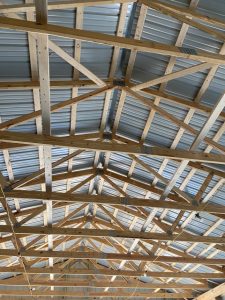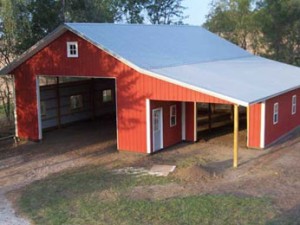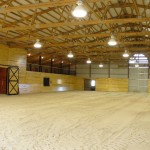Impact of Weather on Metal Plate Connected Wood Trusses
Proper jobsite storage of trusses has always been near top of my personal list. If in doubt, I recommend erring towards caution’s side. Hansen Pole Buildings’ Construction Manual addresses proper truss handling and storage:
“Trusses store best when standing upright.
Shore and brace standing trusses well to keep from toppling. Trusses not stored in a vertical position can and will warp, and become difficult to use.
Store trusses with “tails” (overhangs) so truss weight does not rest on tails.
Unload trusses in bundles and store on level ground, but never in direct contact with ground (to avoid collecting moisture from ground). Allow for good drainage at truss storage location in event rain occurs before installation. Protect trusses from damage resulting from on-site activities, environmental conditions or elements. Exercise care at all times to avoid damage to trusses due to careless handling during delivery, unloading, storage, and installation.
In warm, rainy weather, moisture regain in unprotected trusses can result in fungal staining. Wetting lumber also results in swelling. Subsequent shrinkage of framing may contribute to structural distortions.
To store trusses not being used immediately, cover with a water repellant opaque tarp for protection. Plastic may be an acceptable alternative, provided there are side openings to allow air flow. Handle trusses in such a way as to prevent toppling when removing banding from bundles. Trusses stored on black top or other impervious surfaces and continuously moved around construction site are subject to damage when they are slid along surface with equipment. As a result, galvanized coating on connector plates may be removed, allowing plates to rust and possibly reduce plate thickness.”
(Portions of this article, below, are from an August 7, 2018 article by Sean Shields and Kirk Grundahl, P.E. published in SBC Magazine)
 In 2000 and 2004 Alpine (Alpine manufactures steel connector plates for trusses https://alpineitw.com/ ) undertook a weathering study entitled Durability of Plates, R&D #90-07 dated January 3, 2000 and January 22, 2004. Mr. Stu Lewis provided this report to SBCA (Structural Building Components Association) to aid SBCA with background information regarding a common notion truss plates back away from lumber under short term (i.e. less than nine months of outside storage) weather exposure. Key concepts from this report, given an Orlando exposure condition from July 1998 to December 1998 follows:
In 2000 and 2004 Alpine (Alpine manufactures steel connector plates for trusses https://alpineitw.com/ ) undertook a weathering study entitled Durability of Plates, R&D #90-07 dated January 3, 2000 and January 22, 2004. Mr. Stu Lewis provided this report to SBCA (Structural Building Components Association) to aid SBCA with background information regarding a common notion truss plates back away from lumber under short term (i.e. less than nine months of outside storage) weather exposure. Key concepts from this report, given an Orlando exposure condition from July 1998 to December 1998 follows:
CONCLUSIONS
- No particular plate type in this study showed markedly different back-out performance or retained tooth holding capacity than other plates tested.
- For all plates, storage under cover, even if it was just another joint, was better than direct exposure.
- No excessive corrosion was noted of any type of truss plates, nor were tooth holding reductions considered significant with respect to their magnitude..
- …it appears some exposures, specifically top plate on horizontally oriented truss joint fully exposed to weather, experiences an average loss in tooth holding strength of about 14 percent in a 5-6 month exposure in severe central Florida climate of this study
- this is likely due to occurrence of plate back-out due to repeated wood shrinkage and swelling.
- …it appears some exposures, specifically top plate on horizontally oriented truss joint fully exposed to weather, experiences an average loss in tooth holding strength of about 14 percent in a 5-6 month exposure in severe central Florida climate of this study
- Typical practice of permitting trusses to be exposed to environment for a short period of weeks or even months after truss fabrication and before closing in structure is confirmed as not resulting in an excessive loss in strength and is therefore acceptable with respect to joint strength……..
Alpine results point us in a right direction, even though this is a limited study of truss plate performance due to weathering. However, all truss weathering studies to date have been performed on truss plates and truss plate joints, but never on finished trusses as stored at truss plant or on job site
Typical practice of permitting trusses to be exposed to environment for a short period of weeks or even months after truss fabrication and before closing in structure is confirmed as not resulting in an excessive loss in strength and therefore acceptable with respect to joint strength…
Our (SBCA) goal is to take all background information we can find, along with our SBCA weathering testing program findings, and create a set of best practices to help maintain good truss performance during their entire service life (ideally if we can, it would be nice to see consistent trends, predictable and can be modeled)
From this work we believe SBCA will be able to provide best practice counsel with respect to storage, truss plate performance and, most importantly, define any effect on overall truss performance post-installation.









